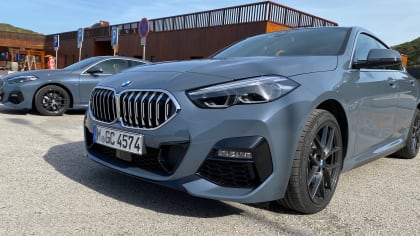How to Measure Bolt Pattern: Complete Step-by-Step Guide 2025

Will These Wheels Fit My Car?
Learn how to measure your wheel bolt pattern accurately. Get step-by-step instructions for 4, 5, 6, and 8-lug patterns plus conversion charts.
By The Editors
Tue, Oct 28, 2025 10:30 AM PST
Safety first - please make sure to use our guide as a reference. Always consult your mechanic as your situation might be unique.
You've found the perfect wheels. The design is spot-on, the finish is exactly what you wanted, and the price fits your budget. There's just one problem: you have no idea if they'll actually bolt onto your car.
Welcome to the world of bolt patterns, the single most important measurement that most people get wrong when buying wheels.
Here's the frustrating part: bolt patterns look simple on paper, but measuring them correctly requires knowing which method to use. Get it wrong, and those dream wheels become expensive paperweights sitting in your garage.
The good news? Once you understand the basics, measuring bolt patterns takes about five minutes and saves you from costly mistakes.
TL;DR: Bolt Pattern Measurement Basics
| What You Need to Know | The Real Story |
| What is a bolt pattern? | Number of lug holes and diameter of the circle they form |
| Format explained | 5x120mm means 5 holes on a 120mm diameter circle |
| Even-numbered patterns | Measure straight across from center to center |
| Odd-numbered patterns | Measure from the center of one hole to the outer edge of the opposite hole |
| Tools needed | Ruler, tape measure, or caliper (caliper is most accurate) |
| Common car patterns | 4x100, 5x114.3, 5x120 for most sedans- |
| Common truck patterns | 6x135, 6x139.7, 8x170 for trucks and SUVs |
| Why accuracy matters | The wrong pattern causes vibration, poor fitment, and safety hazards |
What Bolt Pattern Actually Means
A bolt pattern (also called lug pattern) describes how the lug holes are arranged on your wheel hub. It's written as two numbers: 5x120mm means 5 lug holes arranged in a circle with a diameter of 120mm.
The first number is straightforward, just count the holes. The second number requires measurement, and that's where people mess up.
Think of it like this: the lug holes form an invisible circle. The bolt pattern measurement is the diameter of that circle, measured in either millimeters or inches.
Some wheels are "dual-drill," meaning they have two sets of holes to fit multiple patterns. A 5x112/120 wheel has ten total holes and works with both 5x112mm and 5x120mm vehicles. This gives you more fitment options, but you still need to know your starting pattern.
Types of Bolt Patterns by Vehicle
Different vehicles use different bolt patterns based on weight, performance needs, and manufacturer preferences:
3-lug patterns: Rare, mostly found on vintage cars and some microcars
4-lug patterns: Common on smaller cars, economy vehicles, and older imports
5-lug patterns: Most popular for sedans, sports cars, and crossovers
6-lug patterns: Standard for trucks, SUVs, and heavy-duty vehicles
8-lug patterns: Heavy-duty trucks and commercial vehicles needing maximum load capacity
More lugs generally means more weight capacity and stability, which is why trucks have 6 or 8 lugs while compact cars typically have 4 or 5.
Tools You Actually Need
Don't overthink this. You need one of three tools:
Ruler or tape measure: Works but requires steady hands and good lighting. Accuracy can be off by a millimeter or two.
Digital caliper: Best option for precision. Gives exact measurements and eliminates guesswork.
Bolt pattern gauge: Specialty tool that makes the job foolproof, but unnecessary if you already own a caliper.
For most people, a $20 digital caliper from any hardware store is the sweet spot between accuracy and cost.
How to Measure Even-Numbered Bolt Patterns (4, 6, 8 Lugs)
Even-numbered patterns are straightforward because holes sit directly across from each other.
Step 1: Identify two holes directly opposite each other
Step 2: Measure from the center of one hole to the center of the opposite hole
Step 3: Record your measurement in millimeters or inches
That's it. The measurement you just took is the second number in your bolt pattern.
For example, if you counted 6 holes and measured 139.7mm across, your bolt pattern is 6x139.7mm.
How to Measure 5-Lug Bolt Patterns (The Tricky One)
Five-lug patterns trip people up because no holes sit directly across from each other. The measurement technique is different:
Step 1: Pick any lug hole as your starting point
Step 2: Measure from the center of that hole to the OUTER EDGE of the hole two positions away (skip one hole)
Step 3: Record your measurement
This gives you the bolt circle diameter. Common 5-lug patterns include:
- 5x100mm (many imports)
- 5x114.3mm (common on American and Japanese cars)
- 5x120mm (BMWs and some trucks)
The difference between 5x114.3mm and 5x120mm is only 5.7mm, so precision matters. This is why a caliper beats eyeballing it with a ruler.
Alternative Methods When You Don't Want to Measure
Not everyone wants to break out measuring tools. Here are your shortcuts:
Check your vehicle manual: Most owner's manuals list bolt pattern in the specifications section. Look for "wheel specifications" or "tire and wheel information."
Use a bolt pattern gauge: These templates have cutouts for common patterns. Line it up with your hub, and it tells you the pattern instantly.
Look up your vehicle online: Search "[year] [make] [model] bolt pattern" and you'll find it listed on multiple databases. Just make sure the year and trim level match exactly.
Ask a tire shop: Any tire or wheel shop can tell you your bolt pattern in about 30 seconds. Most won't charge for this.
Making Wheel Removal Easier for Accurate Measurement
While bolt patterns can sometimes be measured with wheels mounted, removing the wheel gives you the clearest view and most accurate access to the hub face—especially when dealing with deep-dish wheels or tight spoke designs that obscure the mounting surface.
For home mechanics who frequently work on wheels—whether measuring fitment, rotating tires, or doing brake work—a 2-post car lift provides stable, safe access to all mounting points. This is particularly valuable when test-fitting multiple wheel sets or verifying measurements on all four corners without repeatedly jacking and lowering the vehicle. The investment makes sense for those who do regular wheel swaps or maintenance, though for a one-time measurement, jack stands work fine.
Bolt Pattern Conversion: Millimeters to Inches
Some manufacturers list patterns in millimeters, others use inches. Here's how they convert:
| Lug Count | Millimeters | Inches |
| 4-Lug | 4x100mm | 4x3.94" |
| 4x114.3mm | 4x4.5" | |
| 5-Lug | 5x100mm | 5x3.94" |
| 5x112mm | 5x4.41" | |
| 5x114.3mm | 5x4.5" | |
| 5x120mm | 5x4.72" | |
| 6-Lug | 6x139.7mm | 6x5.5" |
| 6x135mm | 6x5.31" | |
| 8-Lug | 8x165.1mm | 8x6.5" |
| 8x170mm | 8x6.69" |
Note that conversions aren't always perfect, 5x4.5" and 5x114.3mm are the same pattern, even though 4.5 inches technically equals 114.3mm.
Common Bolt Patterns by Vehicle Type
Compact cars and sedans:
- Honda/Acura: Often 5x114.3mm
- Toyota/Lexus: Mix of 5x100mm and 5x114.3mm
- BMW: Typically 5x120mm
- Volkswagen/Audi: Usually 5x112mm
Trucks and SUVs:
- Ford F-150: 6x135mm
- Chevy Silverado: 6x139.7mm (also called 6x5.5")
- Dodge Ram 2500/3500: 8x165.1mm
- Toyota Tacoma: 6x139.7mm
Performance and sports cars:
- Corvette: 5x120mm
- Mustang: 5x114.3mm
- Porsche: 5x130mm
Always verify your specific year and model, as patterns can change between generations. When shopping for wheels, such as black alloy wheels, knowing your exact bolt pattern prevents ordering mistakes.
Why Accurate Measurement Actually Matters
Getting the bolt pattern wrong isn't just inconvenient; it's dangerous.
Safety issues with wrong patterns:
- Wheels wobble or vibrate at highway speeds
- Lug nuts don't torque properly, risking wheel detachment
- Uneven pressure on hubs causes premature bearing failure
- Handling becomes unpredictable in emergency situations
"Close enough" doesn't work with bolt patterns. A 5x114.3mm wheel won't safely fit a 5x120mm hub, even though they look similar.
Some people try using adapters to make incompatible patterns work. While adapters have legitimate uses, they add rotating mass, change your wheel offset, and create additional failure points. Starting with the correct pattern is always safer.
Special Considerations for Large Wheels
If you're considering oversized wheels like 28-inch rims, the bolt pattern becomes even more critical. Larger wheels put additional stress on lug studs and hubs.
With bigger wheels:
- Torque specifications become more important
- Hub-centric rings may be necessary for proper centering
- Load ratings need to match or exceed OEM specifications
- Offset and backspacing affect clearance and handling
Many aftermarket wheel manufacturers build their large-diameter wheels with common bolt patterns, but always verify before ordering. The larger the wheel, the more expensive the mistake if you get the pattern wrong.
What to Do If You're Between Two Measurements
Sometimes your measurement falls between two common patterns. For example, you measure something around 113mm-115mm and can't tell if it's 5x112mm or 5x114.3mm.
Here's what to do:
- Measure again with a better tool (upgrade to a caliper if using a ruler)
- Look up your vehicle's specs online to confirm
- When in doubt, ask a professional; most tire shops verify for free
- Don't guess and order wheels hoping they'll fit
The difference between 5x112mm and 5x114.3mm is only 2.3mm, but that's enough to cause serious problems. Get it right the first time.
The Bottom Line on Bolt Patterns
Measuring your bolt pattern isn't complicated once you know the right method. Even-numbered patterns measure straight across; odd-numbered patterns use the center-to-outer-edge technique.
A cheap digital caliper gives you accurate measurements in seconds. If you don't want to measure, your vehicle manual or a quick online search works just as well.
Getting the bolt pattern right is non-negotiable. Wrong fitment causes safety issues, vibration, and premature wear on expensive components. Take the five minutes to measure correctly, and your new wheels will fit perfectly the first time.
Complete Truck Upgrades Beyond Wheels
Once you've got your wheel fitment sorted, many truck owners look at other functional upgrades. Beyond suspension and wheel changes, protecting your truck bed ranks high on the modification list. A quality trifecta tonneau cover keeps cargo secure and improves fuel efficiency by reducing drag—practical upgrades that complement your wheel investment.
Frequently Asked Questions
How do I measure a 5-lug bolt pattern?
Measure from the center of one lug hole to the outer edge of the hole two positions away (skipping one hole). Use a caliper for accuracy. This gives you the bolt circle diameter, the second number in your pattern, like 5x114.3mm.
Do rims have the bolt pattern stamped on them?
Sometimes, but not always. Some aftermarket wheels have the bolt pattern stamped on the back or listed on a sticker. Many wheels, especially OEM wheels, don't have any markings. Don't rely on finding it stamped; measure or look up your vehicle specs instead.
Are all 5-lug patterns the same?
Absolutely not. Common 5-lug patterns include 5x100mm, 5x112mm, 5x114.3mm, 5x120mm, and 5x127mm. Each is different and not interchangeable. Always verify your specific pattern before buying wheels.
Can I measure the bolt pattern without removing the wheel?
Yes, but it's harder. You can measure through the wheel spokes if you have access to the hub. A bolt pattern gauge works best for this method. Removing the wheel makes measurement easier and more accurate.




